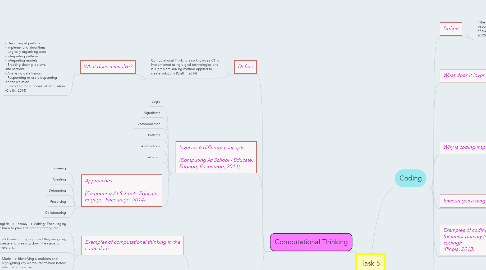
1. Computational Thinking
1.1. Define
1.1.1. Computational Thinking also known as CT is implemented using digital technologies and is a problem solving method applied to create solutions (Crellin, 2014).
1.1.1.1. What does it involve?
1.1.1.1.1. - Designing algorithms - Implementing algorithms - Logically organising data - Interpreting patterns - Interpreting models - Breaking down problems into sections - Analysing data trends - Responding to users depending on the situation - Predicting the outcome of stimulation (Crellin, 2014)
1.2. Involves 6 different concepts (Computing At School - Educate, Engage, Encourage, 2014)
1.2.1. Logic
1.2.2. Algorithms
1.2.3. Decomposition
1.2.4. Patterns
1.2.5. Abstractions
1.2.6. Evaluation
1.2.7. Approaches (Computing At School - Educate, Engage, Encourage, 2014)
1.2.7.1. Tinkering
1.2.7.2. Creating
1.2.7.3. Debugging
1.2.7.4. Preserving
1.2.7.5. Collaborating
1.3. Year Level Descriptions (SCSA, 2014)
1.3.1. Examples of computational thinking In the curriculum
1.3.1.1. English --> Literacy --> Writing: Encouraging children to plan first before drafting etc.
1.3.1.2. Art --> Brainstorming a project they are going to create and breaking down the steps to achieve this.
1.3.1.3. Maths --> identifying a problem and highlighting key words/information before attempting to solve it.
1.3.2. Pre Primary
1.3.2.1. Focus on developing foundational skills in computational thinking.
1.3.3. Year 1
1.3.3.1. Learning focuses on expanding on foundational skills in computational thinking
1.3.4. Year 2
1.3.4.1. Learning focuses on broadening students prior skills in computational thinking and providing opportunities for engaging in personal and social experiences when using digital systems.
1.3.5. Year 3
1.3.5.1. In Year 3, students further develop understanding and skills in computational thinking, such as categorising and outlining procedures.
1.3.6. Year 4
1.3.6.1. In Year 4, students further develop understanding and skills in computational thinking, such as categorising and outlining procedures. They have opportunities to create a range of solutions, such as interactive adventures that involve user choice, modelling simplified real world systems.
1.3.7. Year 5
1.3.7.1. In Year 5, students further develop understanding and skills in computational thinking, such as identifying similarities in different problems and describing smaller components of complex systems.
1.3.8. Year 6
1.3.8.1. In Year 6, students further develop understanding and skills in computational thinking such as identifying similarities in different problems and describing smaller components of complex systems.
2. Reference List
3. Coding
3.1. Define
3.1.1. "The symbolic arrangement of data or instructions in a computer program or the set of such instructions" (Princeton University , 2012).
3.2. What does it involve?
3.2.1. Variety of different coding languages are used.
3.2.1.1. e.g. Python Javascript SQL PHP Ruby C C++ C Sharp
3.2.2. Computer programmers create programs for a computer through writing in a specific code. This provides 'instructions' to the computer to
3.3. Why is coding important?
3.3.1. Powers digital world e.g. computers, smart phones, apple watches etc.
3.3.2. Allows technicians to make different applications, websites and resource that we use in every day life.
3.3.3. Gives children an understanding of technology and how it influences society and the world we live in today.
3.3.4. Children are provided with a better understanding of how computers work and how they are programmed.
3.4. Encourages a range of skills including;
3.4.1. Problem solving
3.4.2. Creativity
3.4.3. Communication skills
3.5. Examples of coding games/programs for junior primary (introduction to coding); (Pinola, 2013)
3.5.1. Daisy the Dinosaur
3.5.2. Move the turtle
3.5.3. Hopscotch
3.5.4. Scratch
3.6. Examples of coding games/programs for middle - upper primary; (Pinola, 2013)
3.6.1. App inventor
3.6.2. Alice
3.6.3. Plural Sight
3.6.4. Code Accadamy
3.6.5. Khan Accadamy
